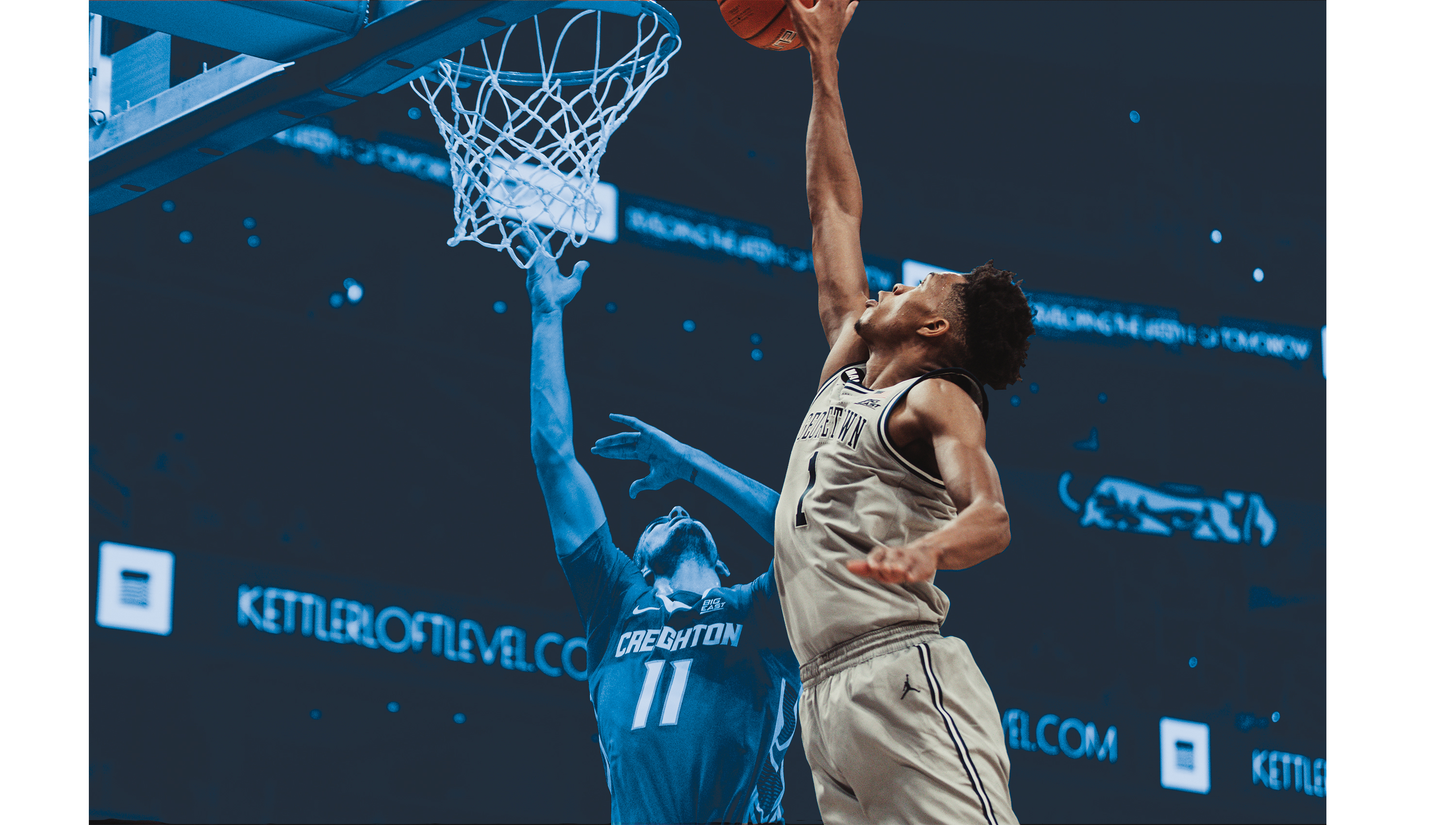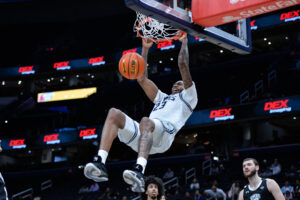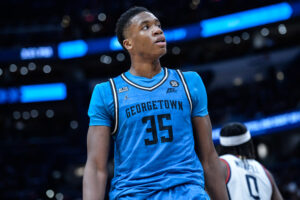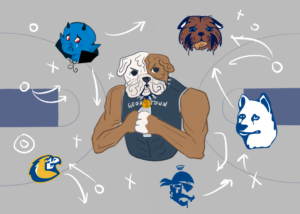This piece is a follow-up to a May 24, 2021 Voice article on Jamorko Pickett.
July 29, 2021. The 2021 NBA Draft. Two rounds to decide the 60 names selected to become the next generation of basketball stars. Georgetown’s sharpshooting wing Jamorko Pickett had just graduated with a bachelor’s degree in fine arts and was fresh off leading his hometown Hoyas to a Big East championship. The draft was his chance to get the validation he knew he deserved. The first round came and went without Pickett hearing his name announced. That was understandable for Jamorko—based on his pre-draft workouts and interviews, he wasn’t expecting to go in the first round; it was the second round or bust for Pickett. But as 60 picks passed by, Pickett’s name was never called.
“It was always in the back of my mind, going undrafted,” Pickett said.
Pickett has always felt underestimated, always chasing the next opportunity against all odds. Pickett went from being ineligible for the basketball team his sophomore year in high school to becoming Eastern High’s de facto leader. From playing a postgraduate year to garner more attention from colleges to becoming a four-star recruit. From being a role player on the Hilltop to leading his Georgetown Hoyas to a Big East title. His whole life had been about proving doubters wrong. About capturing any opportunity available to him. Getting snubbed in the draft would just be another one of these moments where he’d have to work harder than everyone else. Where he’d have to prove himself again. Where he’d have to show the world he was ready.
Jamorko would get that key opportunity just a few short days after the draft. Detroit Pistons general manager Troy Weaver—who had taken a liking to Pickett’s game in the pre-draft process—offered him a spot on the Pistons’ summer league squad where he would compete with others in a similar position for a contract. There was no guarantee of a full roster spot, no guarantee of minutes, just a training camp and summer league invite.
As the NBA Summer League—where young players play exhibition-style games to prove they deserve a spot—kicked off in Las Vegas, Pickett continued to do what he’s always done: perform. After playing in two games off the bench, Pickett had shown enough grit and skill to earn a start. As the entirety of the Pistons’ fanbase exclaimed, “Who?,” Pickett showed them who: 18 points, 7-10 from the field, a perfect 4-4 from deep, and the Pistons’ first summer league win. That’s who. On a team littered with high first-round draft picks, it was the undrafted kid out of Georgetown who stood out.
After a summer of putting up 9.8 points and 3.8 rebounds per game on 54.5 percent from the field and 50 percent from downtown, Pickett had earned himself yet another opportunity. On Sept. 24, 2021, after clearing some room on the roster, the Pistons sent paperwork to Pickett: an official offer for a two-way contract to play for Detroit.
“It was one of the best days of my life, signing that paper,” Pickett said. “It was a step closer to accomplishing my ultimate dream to be an actual NBA player.”
Less than a month passed before Pickett made his NBA debut. In the Pistons’ second game of the season against the Chicago Bulls, Pickett subbed in late in the 4th quarter for mop-up duty. It wasn’t much—when all was said and done, he had played just under a minute and a half of basketball and the Pistons took a loss—but meant everything to Jamorko. The kid from East D.C., the kid who couldn’t play basketball his sophomore year of high school, the kid who went undrafted, had just played in an NBA game.
Jamorko had done it. He had become an NBA player. He knew, however, that there was still work to be done to become a full-time member of the Pistons’ rotation and to establish a winning culture in the Pistons’ locker room. As an undrafted role player, Pickett doesn’t have the leniency to explore his personal game at the expense of team success. He knows that as a fringe guy, he has to be in the right spots at the right time and ensure that the team flows the way it needs to be. He also realizes that he’s not always going to be on the court. But just because he isn’t getting a lot of playing time doesn’t mean he can’t help his team.
“I try to do whatever I can do to help contribute to winning,” Pickett said. “Not so much as being on the court, but in practice making sure I do what I gotta do so the guys can be prepared when they’re ready to play.”
He knows the NBA opportunities will be few and far between. He understands that the Pistons are in rebuilding mode right now. But that’s not an excuse to slack off and just collect a paycheck. Jamorko has never been that type of guy. “[We’re] always gonna do what it takes to win,” he said. He sees himself as a role model for kids who were never star recruits, didn’t have the most athleticism and weren’t lucky enough to be drafted. “I went undrafted, you know. Did my thing in the Summer League, earned a two-way, and I’m still making my way. So it definitely means a lot [to be a role model].”
Many would call it good after stepping onto the NBA hardwood for the first time. But not Jamorko. His journey is only at its beginning. He’s not quite where he wants to be just yet. But that’s OK, Jamorko’s accustomed to this; he had to undergo the same development curve in college.
Pickett began his Georgetown career much like he’s beginning his NBA career: a role player on a team that was mediocre at best. Throughout his four years on the Hilltop, he continued to improve and blossom, eventually becoming one of the team’s main leaders.
In the Hoyas’ magical Big East Tournament run his senior year—where Georgetown, in a Cinderella story, ended up winning the Tournament despite being the eighth seed—Pickett poured in 12 points and eight boards in an upset over Villanova and had a team-high 19 points against Seton Hall the following game.
“Man, I loved my four years at Georgetown. A lot of trials and tribulations. A lot of good times, a lot of bad times. But if I can do it again, I wouldn’t change a thing,” he said.
Luckily for Pickett, he was never alone in his pursuit of excellence. Despite the roller coaster ups and downs he experienced with the Hoyas, he always had his brothers on the Hilltop—his former teammates and his coaches—with him, helping him and pushing him to be great.
“Coach Pat [Head Coach Patrick Ewing] was a huge influence on me, helping me succeed and get to where I am now. The way he coached me, the way he pushed me, the stuff he taught me,” Pickett added.
Even today, Pickett still has regular conversations with his former head coach, who had an illustrious NBA career. According to Pickett, Ewing gives him advice not only about basketball and his game, but also about NBA life in general. Every little thing Coach Ewing tells him he absorbs.
“He’s come a long way,” Ewing said at last year’s Big East Tournament. “He didn’t complain, he just kept working, kept persevering, and here he is now.”
You have to take everything in—every piece of advice, every amount of constructive criticism, every small little detail—when you’re like Pickett, fighting day in and day out for playing time. It’s not just his coaches that he listens to, either; he’s quickly developed a relationship with second-year pro Saddiq Bey on the Pistons, whom he talks to all the time about how to improve.
“I’ve talked to Saddiq [Bey] a lot,” Pickett explained. “He’s only in his second year, but he’s got the mind of a vet. So, you know, I talk to him, I pick his brain a lot.”
Bey, a fellow DMV native, played against Pickett a few times prior to both joining the Pistons franchise: in the AAU circuit as well as in college when Bey was a Villanova Wildcat. Both he and Pickett know what it means to represent this area—you have to be a fighter. You have to be gritty. You have to play hard.
Jamorko has always been exactly that. He’s always been someone who faces adversity head-on. And he wants to bring that same attitude to the NBA. As a two-way player, Jamorko’s role isn’t like being just a regular bench player. Not only do you have to deal with getting spot minutes off the bench on the backend of an NBA rotation, you also have to grapple with the roller coaster of a two-way contract that dictates where you will play, splitting time between the G League and the NBA. You don’t get the same attention in practice that the starters or the bench guys do. Being sort of a ‘tweener’—too good for the G League, but still developing skill for the NBA—makes it tough to juggle being a leader down with the Pistons’ G League affiliate Motor City Cruise while still being a positive contributor with the big league club. It’s not an easy task, but Jamorko is taking the challenge in stride.
“I think it’ll be a process like that for the rest of my career,” Pickett remarked. “There’s always going to be a juggle, there’s always going to be a struggle—mine’s just being called to the Pistons or the Cruise.”
While his NBA minutes haven’t been numerous, so far, the G League results speak for themselves. Pickett is averaging 15.1 points per game and 5.6 rebounds a game on 44.7 percent from the field as a starter for the Eastern Conference-leading Motor City Cruise. And after missing almost a full month of action rehabbing a foot injury, Pickett came right back like he never left with 12 points (5-10 FG), four boards, two assists, and two steals in his return to the G League in late February. As much as playing basketball means to Pickett and as great as it is that he’s returned to action for the last stretch of the season, there is one thing he values more than anything else: his city.
Jamorko embodies his hometown like few other athletes and few other people do. Growing up in eastern D.C., going to high school at Eastern High, playing basketball at Georgetown—everything Pickett does is intertwined with his hometown. “It means the world to me and my family,” Pickett said about the surreal feeling of playing basketball at the highest level in his hometown. “I love where I’m from. It shaped me to be who I am today.”
Even though he’s playing basketball 400 miles away from the place he grew up, Jamorko still sets his Twitter location to his hometown. Every time he comes back to D.C. when the Pistons play the Washington Wizards or when the Cruise play the Capital City Go-Go, Pickett posts on his Instagram story about playing back home. D.C. is still a part of him.
Jamorko’s story is only beginning, but it will always be rooted in D.C.—the city he grew up in, the city he went to college in, the city he’ll always call home. As someone who grew up in D.C.’s Ward 6, someone who’s high school closed down after his freshman year, someone who didn’t even get drafted, he wasn’t supposed to be here. Wasn’t supposed to be playing basketball at the highest level. Wasn’t supposed to be representing his city. Yet here he is. Jamorko Pickett is ready to shine with his city always behind him.
“No matter where I am, no matter where I play,” Pickett said. “D.C. will forever be home for me.”





